5 Cars That Prove There’s Love for the Unexceptional
Almost ten years ago, I was part of the team that gave birth to a much-loved Hagerty U.K. event: The Festival of the Unexceptional. FOTU, to this day, is a celebration of extraordinary examples of the most mundane—and in some cases, plain disappointing—automobiles ever built. The event made people realize how low the survivorship rate is for many of these generally unloved cars. These days, the market is perhaps finally waking up to the fact that many of the cars that were the butt of jokes—the rides that were the one-time Nickelbacks of the automotive world—are now legitimately rare and interesting collector cars. Lately, we’ve taken note of some eye-popping sales (and enthusiastic bids that somehow didn’t meet reserve) of what are, almost certainly, the sweetest examples of some of the most maligned cars ever made. We submit these for your disapproval:
1977 Chevrolet Chevette
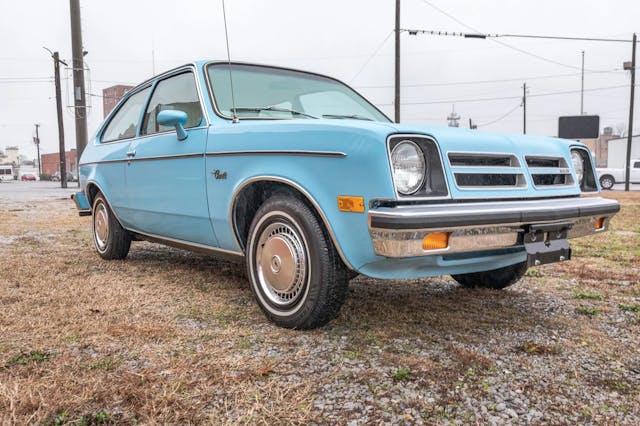
Sold for $22,050
When the Chevette debuted in the U.S. for the 1976 model year, it already seemed like a vestige of a prior era. It was rear-wheel drive at a time when small cars like the Fiat 128 and VW Golf/Rabbit had demonstrated that the future of the compact car was in powering the front wheels. The Chevette was middling but apparently sturdy, until rust claimed almost all of them.
This light blue one showed 5000 miles on the odometer and was lavishly equipped with full wheel covers and an AM/FM radio. Oh, and it had A/C too, something which no doubt sapped at least 15 of the 60 available horses. The shocking final price of $21,000 reflects the fact that while these cars have all but disappeared, nearly everybody of a certain age seems to have a fond Chevette story. Good memories in maligned cars are still good memories.
1976 Chevrolet Vega
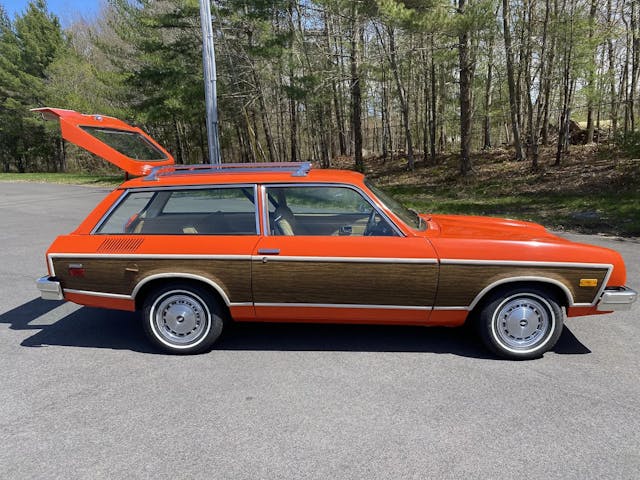
Sold for $12,337
The Vega was less of a joke than a genuine Greek tragedy. It could have been a really decent car but for GM’s dreadful execution. It was pretty, handled well, and it was affordable. Sadly, the prone-to-overheating aluminum-block engines had a two-stroke’s appetite for oil, and the only way in which Vegas were competitive with Toyotas of the day was in their penchant for the tin worm.
True story: My best friend in high school owned a five-year-old Kammback just like this one. It only had 40,000 miles on it, but it used a quart of oil with nearly every fill-up. The car’s cowl had rusted so badly that the windshield was slipping down towards the firewall, leaving a half-inch gap at the top where air would rush in. My solution was to wad up some newspaper to prop up the piece of glass. Pretty elegant if I do say so myself. This example is almost impossibly rust-free, especially for one with 70,000 miles. For heaven’s sake, there’s even a receipt for rebuilding the 8-track player. And that pretty much explains the car’s state of preservation. The new owner shipped it to France, where it’s reputed to be the only one in the country.
1989 Maserati BiTurbo
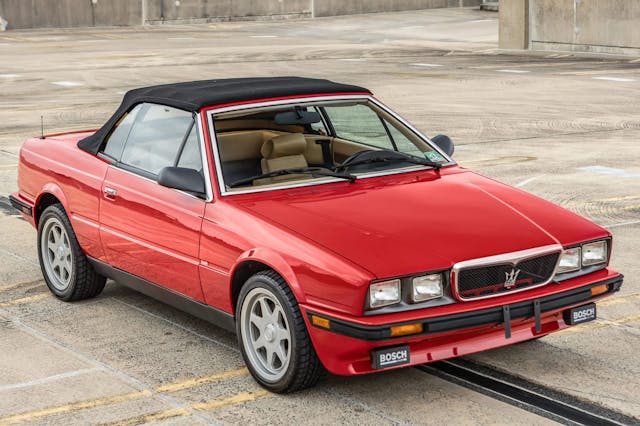
Bid to $16,750
The BiTurbo had among the worst reputations of cars sold in the U.S. in the 1980s. Early carbureted examples had a propensity to catch fire from running too rich of a mixture through the cats, and the fallout nearly destroyed Maserati’s status as a prestige brand. I suppose it made sense at the time; the BiTurbo was positioned as a more potent, more luxurious, and slightly more expensive competitor to the E30-generation BMW 3-series. Instead, to many, it came off as a cynical cash grab by Maserati’s owner, Alejandro De Tomaso. To my eyes, it also looked disturbingly like a Cadillac Cimarron.
More of these cars seem to survive in Europe, where they are unencumbered by emission controls and their mechanical bits are better understood. In the U.S., most BiTurbos tend to be of the “ran when parked” variety, perhaps discovered when the new owner of a distressed property cuts the grass for the first time in ten years. This example was a later, much-improved fuel-injected car that attracted a bid over fifteen grand.
1969 Subaru 360
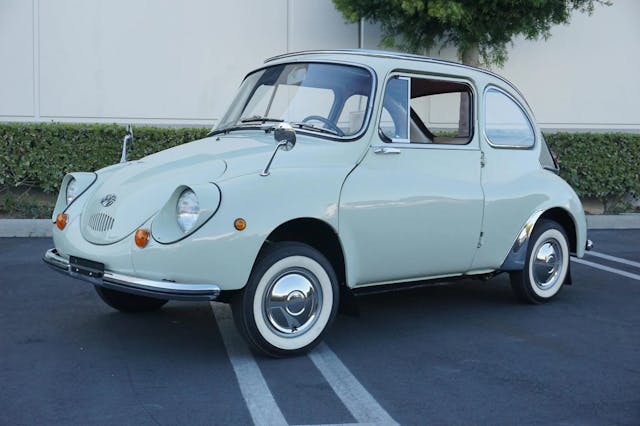
Bid to $35,500
Road & Track summed up Subaru’s first effort in the U.S. thusly: “Any car that takes over 27 seconds to cover a standing quarter-mile, and is only going 46 mph at the end of that quarter, has no business in American traffic.” Consumer Reports said that the bumpers were ineffective against anything sturdier than a watermelon. Until the Yugo came along several decades later, the 360 was probably one of the most scorned new cars ever to be tested by U.S. magazines.
Today, it’s largely forgotten by everyone, including Subaru. Surviving U.S. market cars are indeed unicorns and, as such, are likely to attract more attention at your local cars and coffee than a Koenigsegg. Still, it’s nearly incomprehensible that even in a heady 2022 market, a $35,500 bid wasn’t enough to get this car sold. (To read our 2021 market deep-dive on the surprising Subaru 360, click here.)
1980 Pontiac Phoenix

Sold for $17,587
Entire books have been written for the sole purpose of excoriating the GM X-cars. They were GM’s first mass-market front-wheel-drive sedans, and they had immense potential to be very good cars. In fact, they initially sold quite well. But it’s called the Malaise Era for a reason, so you know how this story ends—”ignominiously” is probably too kind of an adverb.
GM made a number of tweaks to the X-body’s braking system before the new platform entered production, but it didn’t take long for problems to arise. “Media criticism and consumer complaints of X-car stability during braking” drew the National Highway Traffic Safety Administration’s attention, according to an internal NHTSA memo dated June 26, 1981. A lengthy and public back-and-forth ensued between the agency and GM about how to resolve the issue, and the public quickly soured on the cars. Braking wasn’t the only issue, either—the cars were prone to rust, and quality control was lacking. It was an unfortunate misstep in the pivot to more economical front-wheel drive architecture.
Extant X-cars of any variety are rare, and this four-speed manual, nicely equipped 32,000-mile Pontiac Phoenix, with a lurid red velour interior, an insanely full gauge package, and a CB radio, might just be one of the best X-cars left. The price: over $17,500 with the buyer’s fee. Remarkable!
***
Check out the Hagerty Media homepage so you don’t miss a single story, or better yet, bookmark it. To get our best stories delivered right to your inbox, subscribe to our newsletters.
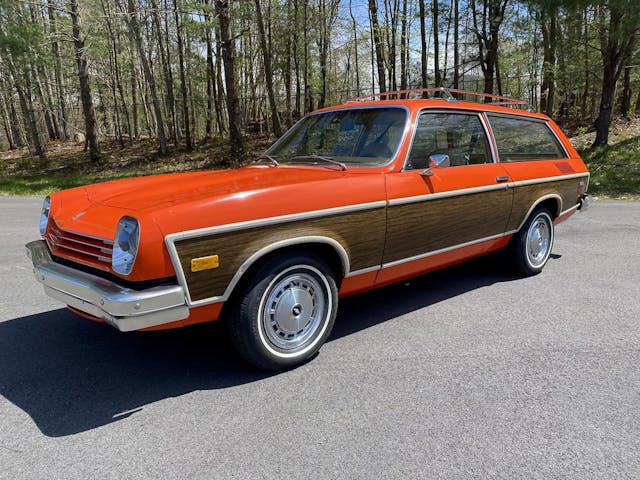


Hah! My first ‘new’ car was a 1980 Chevrolet Citation with the V6 engine, which required power brakes if a manual transmission was selected. I had the rear brakes lock up on a slightly wet road, resulting in a rollover after a curb strike. Stupid me, I bought a second one and quickly discovered it has similar behavior on lower friction surfaces. Three years later, the Class Action suit against GM for brakes was announced. It affected mostly the combination of V6 and manual transmissions (which required the power brakes). Not to mention the numerous failures including the 2nd gear synchro, which made the 1-3 shift crazy as the gearing was NOT close ratio – 4th was an overdrive). Lots of recalls – clutch self adjusting mechanism, the aforementioned transmission, internal power steering leaks resulting in no assist when cold, for a few turns, etc.). And, when I noticed red fluid leaking from the bell housing area, I opened the oil pan with the assistance from a friend with a lift. We found, and I have no explanation for this, that the engine did not have a rear main seal. I have no idea why it didn’t leak earlier, or worse, and of course the dealership wouldn’t believe me when I told them. This undoubtedly led to the need to replace the clutch before 50k miles, while the transmission was being repaired (synchro issue), the only car I’ve ever owned that needed a clutch before 120k miles!
The car was a good drive on smooth roads, but the back end bounced on rough surfaces, especially when cornering. At the time, it was one of few cars that could accelerate from 0-60 in less than 10 seconds, according to the various magazine tests of the day. These later had follow ups that questioned whether the ‘press vehicles’ had been specially selected!
Red fluid is usually automatic transmission fluid. You said your car was a manual transmission, and the engine had no rear main seal. Did you mean the *transmission *input *shaft seal was “missing”? I’d have to side with the dealer on this one…
The Vega rust must be a rust belt thing. I owned a 1976 hatch in factory paint that had not a spot of rust on it at 8 years old. It also had a 327 and 2 speed powerglide that someone had transplanted. Nice cushy bucket seats, handled great and was an absolute rocket. I could completely bury that 80 mph speedo. The only drawback was the manual steering with that V8 sitting over the front tires. You’re spot on about the cars though. With a minor bit of improvement and a better engine, they could have been great cars.
I would walk, bike or ride the bus before I owned one of those turds.
My mom drove an early Vega. Green, auto, and we lived in California. It DID have a problem with the head gasket, but a loaded 18 wheeler running a stop sign put an end to it. Hit the drivers door, but my mom was able to be extracted from the passenger side. No major injuries, so they WERE put together well.
This same phenomenon creates most collectible markets. At some point, everyone disposes of something that was once cheap and ubiquitous. When a clean example surfaces it’s special. Comic books and baseball cards spring to mind. For anyone who doesn’t already know: anything marketed as collectible when new will NEVER be collectible.
“Limited Edition” – limited to as many as we can sell.
You mean my beanie babies are worthless??
“$35,500 bid wasn’t enough to get the Subaru 360 sold.”
Seriously? You’ve GOT to be kidding!
ad a friend in California with a red Vega and got 130k out of it. The joke was it was made on a Wednesday, the day of the week GM did their best work.
Had a Pinto in the 70s, which I would consider in the same group as that lot above. I took good, not great, care of it. Drove it in high school, college, then grad school with usual maintenance – tires, brakes, clutch at 90K. It was a great car for me. Must have been the exception.
Like others, I bought a ‘71 Vega in ‘77 as a winter beater. 6 year old car, straight, no accidents with 45,000 miles. Paid $150. Was rusted pretty bad, the hood eventually became a liftoff since the inner fenders rusted to the point the hinges weren’t attached anymore. Quart of oil every fill-up, plus a can of that STP oil additive glop occasionally. Carpets were usually soaked from the almost non-existent floors and the shifter had so much play it was sometimes hard to tell what gear it was in.
But the heater worked and it made it through the winter. By summer at about 52,000 miles it developed a severe knock and I limped it to the nearest junkyard.
Chevette? Really?
A 1980 Chevette was the only brand new car that I ever bought. I bought it for my wife. I am still shellshocked that EVERYTHING was optional on the car to keep the advertised price low.
Backseat? Optional!
Glove box door? OPTIONAL!
I could go on and on but after that experience, I have never bought a brand new car again.
Wow, good luck to whomever paid $22K for a Chevette. My mother drove one in the 70’s. I borrowed it once when I was in my teens on a misty day and had the most terrifying drive of my life. Rear drive, no weight in the back end, lost the rear end during every slight turn. Never drove it again and insisted she sell it asap. Simply dangerous!
I bought a ’76 Vega wagon similar to the illustration with 49K on the clock circa 1980 for a kilobuck. My friends nearly laughed me out of town. Supposedly a version with bigger carburetor and a 4spd. But I knew
[and most didn’t] that for that year GM installed iron cyl. liners, and with reasonable care the engine would
run a long time. I had a clutch cable break, timing belt break, a bad plug wire resulted in the catalytic
converter setting the car on fire….. I played in a band, there was room for my gear, I drove it 50K and sold it for $500. Now, who had the last laugh?
I remember when the Vega came out and a guy with a yellow coupe was having so much trouble with it and couldn’t get any satisfaction from the Chevy dealership he mounted a triangular sign on the roof with the dealership name and big lemons on o.
He drove it right through the dealership lot and around the neighborhood.
Ha ha.
Correction…. NEARLY caught the car on fire… melted the rug in front of the passenger seat…
Had a bright orange chevette in high school in northern indiana. Truly a fun car in winter. The car went through huge snowdrifts and never got stuck. The manual trans made it easy to rock and roll out of the snow.
The Chevette outdated? Hardly. It was GM’s first ‘world car’, much as the Escort was at Ford. Twin A arm suspension, overhead cam cross flow head, with an optional weber carburetor and rear sway bar. We had a series of Chevettes in SCCA Solo II competition, and they accounted for themselves pretty well. We regularly outran BMW 2002s and 320is; Our Chevette regularly outran a pair of Cosworth Vegas. Celicas, Capris, Corolla and others were our regular competition. Oh, and it had an optional 4:11 rear end. The big mistake that GM made, and one it has repeatedly made is to create great inexpensive vehicles, then never develop or improve them. In a time when the Impala was redesigned every year, the Chevette hardly changed from intoduction to leaving production. They were simple, tough, and a new one cost 1700$. Sounds like what America needs today.
All that, and in a sub 2000 lb package.